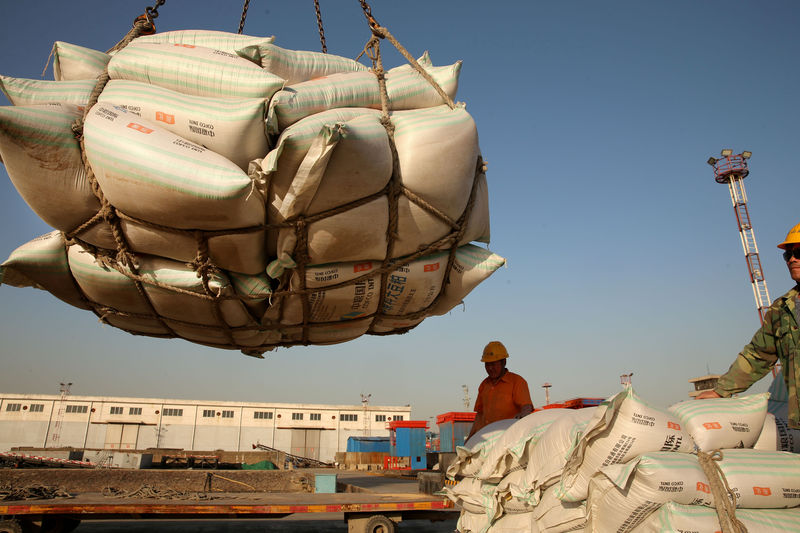By Jeff Mason and David Shepardson
WASHINGTON (Reuters) - President Donald Trump dramatically increased pressure on China on Sunday to reach a trade deal, saying he would hike U.S. tariffs on $200 billion worth of Chinese goods this week and target hundreds of billions more soon.
The move marked a major escalation in tensions between the world's largest economies and a shift in tone from Trump, who had cited progress in trade talks as recently as Friday.
Stock markets sank and oil prices tumbled as negotiations were thrown into doubt.
The Wall Street Journal reported that China was considering cancelling this week's trade talks in Washington in light of Trump's comments, which took Chinese officials by surprise.
A less than rosy update from United States Trade Representative Robert Lighthizer, including details that China was pulling back from some previous commitments, prompted Trump's decision.
"The Trade Deal with China continues, but too slowly, as they attempt to renegotiate. No!" Trump said in a tweet.
U.S. officials did not weigh in on whether China would attend this week's talks. The White House and the U.S. Trade Representative's Office declined to comment. China's commerce ministry did not immediately respond to a request for comment.
"The atmosphere of the negotiations has changed," said a Chinese official with knowledge of the situation.
Whether the talks would proceed and how they would proceed are issues that are now being re-evaluated, the official told Reuters on condition of anonymity.
"All that depends on the attitude of the United States," the official said.
The editor of an influential, Chinese state-run newspaper said Vice Premier Liu He was unlikely to go.
"Let Trump raise tariffs. Let's see when trade talks can resume," Hu Xijin, editor-in-chief of the tabloid the Global Times, tweeted.
The newspaper is published by the ruling Communist Party's People's Daily, but it is not considered an official publication and does not speak for the government.
Chinese media outlets have been told not to independently report on Trump's overnight tweets or tweet about them, and instead adhere to any report from the official Xinhua news agency, said a source with direct knowledge of the matter.
MARKET TURBULENCE
Global financial markets, which had been expecting news of a trade deal soon, went into a tailspin. U.S. equity futures fell more than 2 percent and stocks across trade-reliant Asia tumbled, with China's main indexes plunging 5 percent.
"There is still a question of whether this is one of the famous Trump negotiation tactics, or are we really going to see some drastic increase in tariffs," said Nick Twidale, Sydney-based analyst at Rakuten Securities Australia. If it's the latter, we'll see massive downside pressure across all markets."
Trump said tariffs on $200 billion of goods would increase to 25 percent on Friday from 10 percent, reversing a decision he made in February to keep them at the 10 percent rate thanks to progress between the two sides.
The president also said he would target a further $325 billion of Chinese goods with 25 percent tariffs "shortly," essentially covering all products imported to the United States from China.
Mindful of his 2020 re-election bid, Trump suggested the measures were not leading to price increases for U.S. consumers. "The Tariffs paid to the USA have had little impact on product cost, mostly borne by China," he tweeted.
Tariffs on Chinese goods are actually paid to the United States by the companies importing the goods, and most of those companies are U.S.-based. American businesses, while supportive of Trump's crackdown on China's trade practices, are eager for the tariffs to be removed, not expanded.
"Raising tariffs means raising taxes on millions of American families and inviting further retaliation on American farmers," said Christin Fernandez, a spokeswoman for the Retail Industry Leaders Association.
Nevertheless, the president's aggressive strategy drew rare bipartisan support from U.S. Senate Democratic leader Chuck Schumer, who urged Trump to "hang tough" in a tweet: "Don't back down. Strength is the only way to win with China."
One Chinese trade expert said recent signs of resilience in both economies were breeding over-confidence.
"The urgency is gone. So, it's likely to see a longer trade war," the expert said, speaking on condition of anonymity citing the sensitivity of the topic.
The trade war resulted in billions of dollars of losses for both sides in 2018, hitting industries including autos, technology - and above all, agriculture, while inflicting collateral damage on export-reliant economies and companies from Japan to Germany.
NOT GETTING CLOSE?
Trump's move could backfire, said Tai Hui, Asia-Pacific chief market strategist at J.P. Morgan Asset Management.
"As we learnt a year ago, Beijing could be willing to walk away if the U.S. applies negotiation tactics that they don't agree with. That said, both sides have invested significant time and resources to come this far..."
On Friday, Trump said talks with China were going well.. Treasury Secretary Steven Mnuchin called the round in Beijing "productive," and one White House official told Reuters that dates were being looked at for a potential meeting between Presidents Trump and Xi Jinping in June.
Last week, industry sources said they believed the talks were in the endgame, but a Trump administration official said aides had told the president that significant hurdles remained.
The increase in U.S. tariffs on Friday would be the first since Trump imposed 10 percent tariffs on $200 billion of Chinese goods in September, coming on top of 25 percent tariffs on $50 billion of goods enacted earlier last year.

Negotiations about tariffs have been one of the remaining sticking points between the two sides. China wants the tariffs to be lifted, while Trump wants to keep some, if not all, of them as part of any final deal to ensure China lives up to its commitments, a White House official said on Sunday.